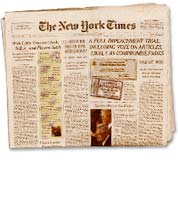
BACK

The New York Times
JANUARY 7, 1999 - REVIEWER: J.D. BIERSDORFER

Filmmaking, Minus the Camera

You enter a musty-looking building that looks as if it is about to fall down around you and continue down a dark hallway until you see an aged security guard snoozing at his desk. Dread and anticipation fill the air as he wakes up and looks over. Is he going to whip out a rifle and blast you?
Nope. Instead, he invites you to look around the building--a run-down film school that is closed for the summer--and learn the art of filmmaking. So goes an early scene in How To Make Your Movie: An Interactive Film School, a CD ROM set with a clever new multimedia approach to learning how movies are put together.
Although it is clearly educational, the program, from Electronic Vision, has made the rounds of the film festivals and was demonstrated at the Telluride Film Festival in Colorado and San Francisco International Film Festival last year. Rajko Grlic, a filmmaker who also holds the title of Eminent Scholar in Film at Ohio University, worked with Tom Erlewine a program designer at Electronic Vision, to create the software.
The Interactive Film School set, created with a filmmaker's eye, is spread over four "floors" of the building in 12 "rooms". Different rooms are devoted to learning about research, screenwriting and pre-production. The equipment room demonstrates different kinds of lighting, like a key light and fill light. There is also a virtual light meter that the user can position on different parts of the screen to test a variety of camera settings. Students at this school also learn the vocabulary of film, including those movie-credit favorites "gaffer" and "best boy". Throughout the course, the program shows the progress and various elements that go into making of a sample student film, "Pasta Paolo".
The story behind the software is almost as interesting as the actual program. The gritty, rambling building used as the interior of the Film School is actually an abandoned 19th-century mental institution near Athens, Ohio. Photographs were taken of the building's rooms and hallways, with the Film School's materials digitally added to the pictures. Inventive text displays like sticky notes, typed sheets and hand-scrawled notes pop up on the walls and doors. There is even a grimy bathroom with a paper towel dispenser that doles out film-history trivia questions on the towels. In addition 2,000 graphics and 100 Quicktime digital movies were created for program.
How to Make Your Movies sells for $89.95 and can be purchased from Electronic Vision at (800) 516-9361 or at www.interactivefilmschool.com. The program runs on Windows 95 and Power Macintosh. The kit has three CD-ROM's and a spiral -bound production notebook for users to keep track of their course progress. The notebook serves as a checklist for the course and also provides training exercises for the student to practice with a video camera. One CD has film clips and sound files for the student to practice editing together.
The program is not intended as a substitute for film school (several film schools do advertise within the program) but as a primer, albeit an extensive one. The creators say that on average, How To Make Your Movie should take a year to complete. And after that final wrap, you can even print out your own diploma. |
|

Awards

|

